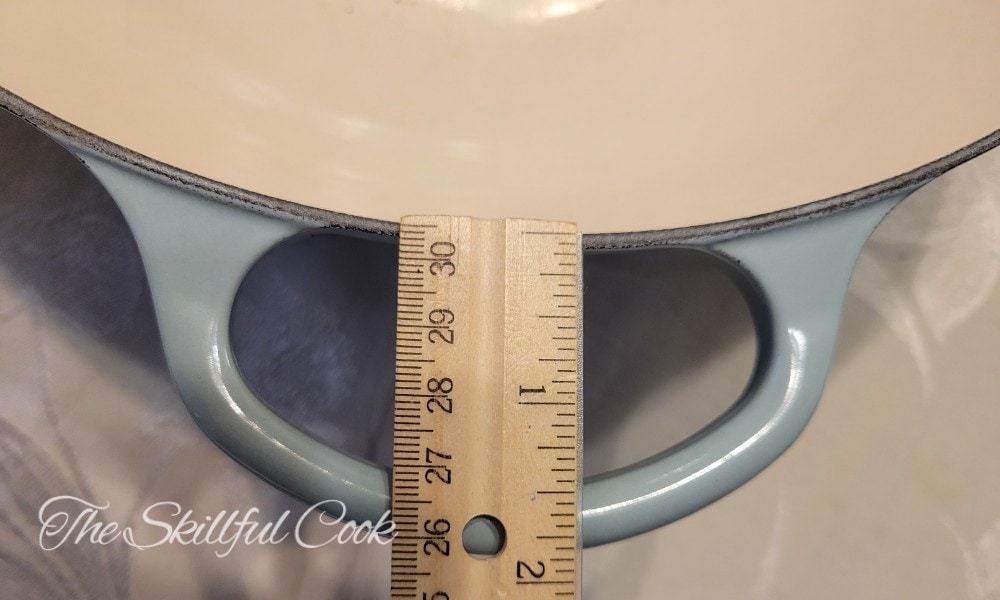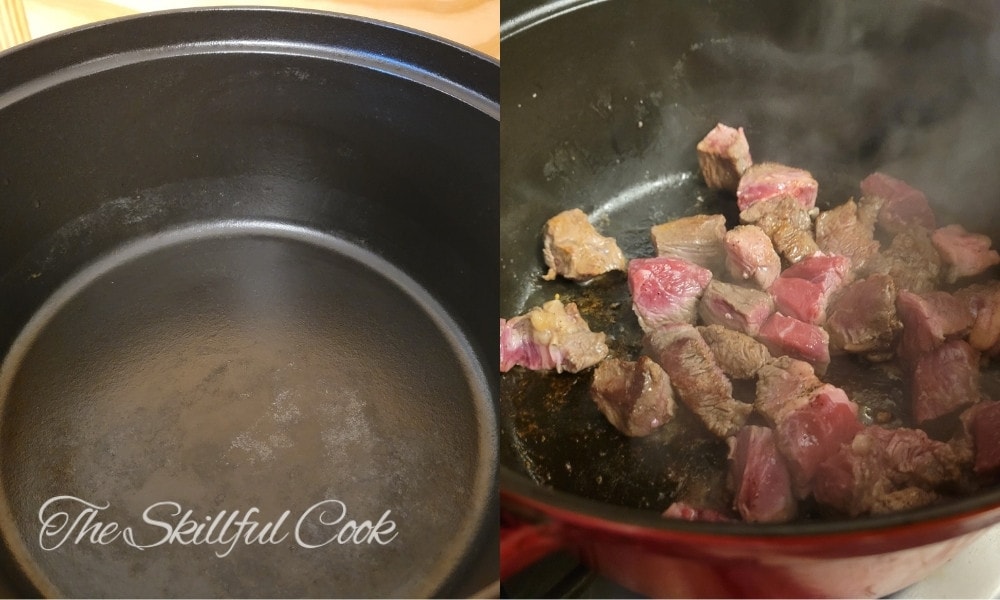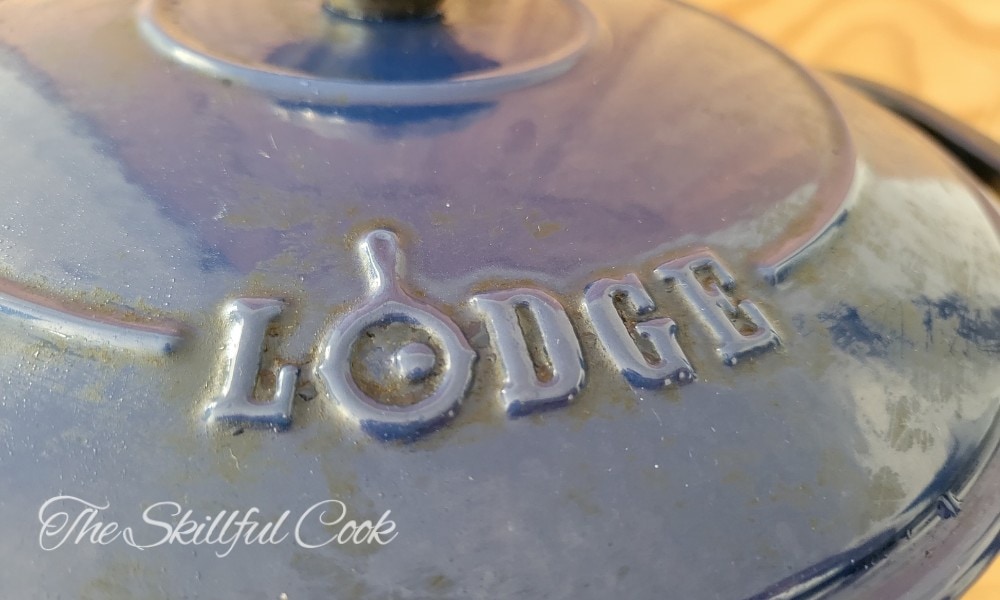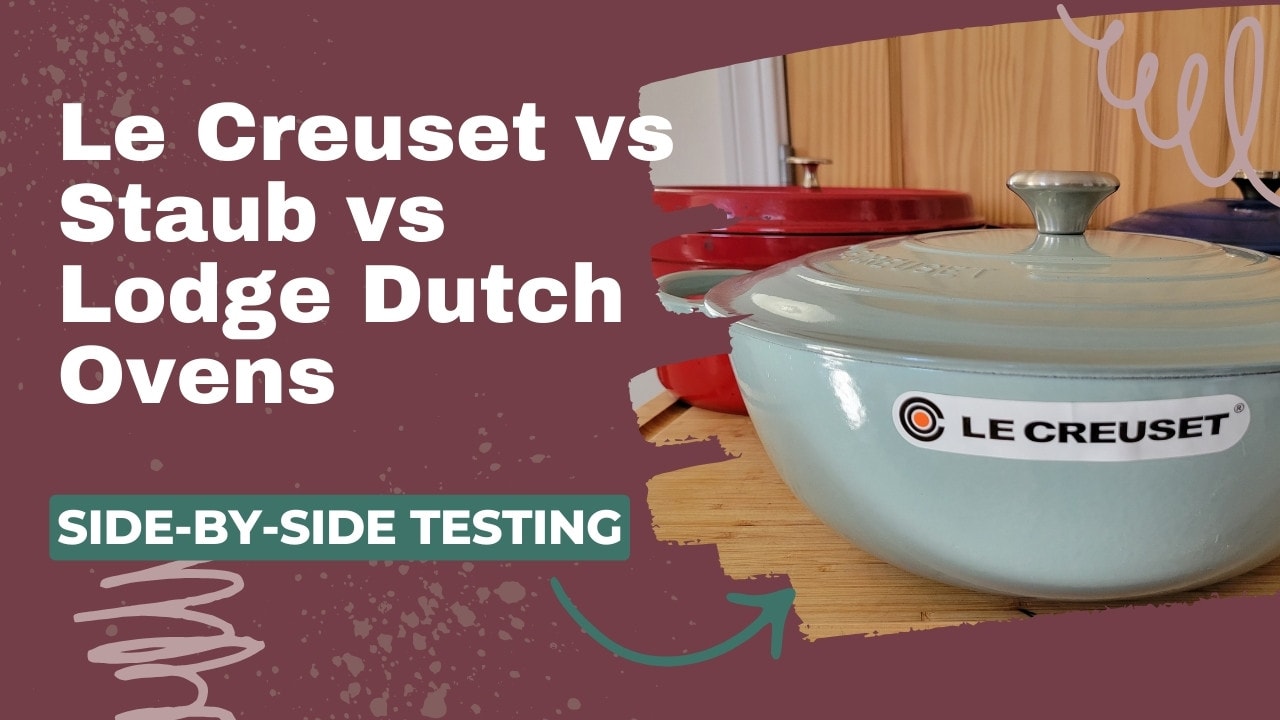French-made Le Creuset and Staub Dutch ovens both have a cult following – but are they really better than affordable options like Lodge? Will you get anything more than bragging rights if you invest in French-made enameled cast iron?
To find out, I borrowed used Dutch ovens from each brand and cooked in all of them for two months. Getting previously loved pots allowed me to see how well they hold up over time. (They were all purchased new by friends from reputable sellers.)

I baked, boiled, seared, and slow-cooked in all three Dutch ovens, checking times and temperatures all the way.
Le Creuset vs Staub vs Lodge – Side by Side Comparison
Top Pick
Our score:
92/100
13.75 inches
10.25 inches
7.25 inches
11.3 pounds
4.0mm
🇫🇷 France
#2 Best Choice
Our score:
90.5/100
11.75 inches
9 inches
6 inches
8.2 pounds
3.6mm
🇫🇷 France
Budget Choice
Our score:
80/100
14.75 inches
11 inches
7.25 inches
12.5 pounds
5.4mm
🇨🇳 China
The Winner: Staub
The Staub is the most powerful oven of the three we tested, best at searing, braising, and bread baking. Its flat lid is designed to drip steam back into the pot.
Pros
Cons
The Runner Up: Le Creuset
Every Le Creuset piece is a work of art as well as an effective cooking vessel. Le Creuset is made of thinner iron than Staub, so it is a bit more responsive to temperature changes.
Pros
Cons
Cheap But Good: Lodge
The “Essential Enamel” Lodge Dutch oven is affordable and a great introduction to cooking in enameled cast iron. It releases more steam when cooking and takes a bit longer to heat up, but it retains heat almost as well as higher-end models.
Pros
Cons
Le Creuset vs Staub

Le Creuset vs Lodge

The biggest differences between Lodge and Le Creuset Dutch ovens are price, aesthetics, and longevity. Le Creuset French ovens have collector value and come in beautiful colors and shapes, while Lodge Dutch ovens are more basic.
Le Creuset products are known to last for generations, but the Lodge Dutch oven I tested had chipped and warped enamel after just a few years. Here are some other major differences:
Staub Cocotte vs Lodge Dutch Oven

Testing The Top Three Dutch Oven Brands
So – Le Creuset vs Staub vs Lodge – which one wins?

The Staub cocotte is my personal favorite. It has the best searing power and it slow-cooks food the fastest, retaining the most moisture.
The Le Creuset French oven is lightweight and easy to work with. It’s more nonstick than Staub and has smoother, easier-to-clean enamel.
But the Lodge Dutch oven exceeded my expectations. It performed almost as well as the higher-end brands, but it’s not a showpiece – or as durable.
Cooking Performance
Heat Distribution and Retention
All three Dutch ovens cooked roast and stew in roughly half the time it would take to braise it in a stainless steel roaster. But the Staub was the fastest at all kinds of slow cooking, thanks to its self-basting lid.

The lid of the Staub cocotte is flat, rather than domed, with conical bumps on the underside that force steam to drip back down into the pot. This design helps meat cook faster and mimics steam injection ovens to give bread a wonderfully flaky crust. You can intensify the steam production by placing ice cubes on the top side of the lid while cooking.

The Lodge also has self-basting “bumps” on the lid, but since the lid is domed and doesn’t seal very well (it let out a LOT of steam in my tests), they didn’t seem to be very effective.

The Water Test
To test heat distribution and retention – and also moisture retention – I boiled 2 quarts of water in all three pots. With a power level of 6 on my stove, I tracked the amount of time water took to come from 70°F to a boil (212°F on the thermometer). I let it simmer for 5 minutes. Then I removed the pot from the heat. I set a timer and checked the internal temperature at 30 minutes and 60 minutes to determine heat retention. Finally, once cool, I measured the water left to check water loss.
| Le Creuset | Staub | Lodge | |
|---|---|---|---|
| Time to 212°F | 8 min 38 sec | 9 min 10 sec | 9 min 44 sec |
| Temp at 30 min | 161°F | 166°F | 156°F |
| Temp at 60 min | 130°F | 132°F | 127°F |
| Water retention | 91.8% | 95.3% | 87.5% |
Le Creuset, since the iron is thinnest, came to a boil the fastest. But, surprisingly, it retained heat better than the thicker Lodge.

The Staub retained the most heat – but after 30 minutes, the three ovens were within 10 degrees of each other. And after 1 hour, they were within 5 degrees of each other.
So the Lodge performed almost as well as the more expensive brands.

The Lodge lost significantly more moisture than the other two – and I could see the steam billowing out of it while it cooked, even with the lid on. Some chefs consider this a benefit, as stews reduce and flavors intensify when moisture is released.
Build Quality
You’ll notice when handling a Le Creuset piece that it’s lighter than you expect. That’s because it’s made of alloyed iron cast thinner than other brands. The 7.5 qt Le Creuset that I tested weighed 13 pounds, 11 ounces with the lid. The 7 qt Staub weighed 14 pounds, 14 ounces.
The Lodge had the thickest walls and was the heaviest for its size. This probably means that the Lodge iron has the highest carbon content and is the most brittle of the three.
| Le Creuset - 7.5 qt | Staub - 7.0 qt | Lodge - 5.5 qt | |
|---|---|---|---|
| Thickness | 3.6mm | 4.0mm | 5.4mm |
| Weight with lid | 13 lb, 11 oz | 14 lb, 14 oz | 11 lb, 8 oz |
| Weight without lid | 8 lb, 8 oz | 9 lb, 15 oz | 7 lb, 13 oz |
The enamel on all three Dutch ovens stained with use– but the Le Creuset was the least stained and easiest to clean.

Only the enamel on the Lodge was damaged beyond something I could clean up. (See photos.) The exterior enamel on the Lodge was disfigured and the interior developed a small chip.

There was also a tiny spot of rust on the rim of the Le Creuset, revealing a weakness in the enamel primer. I removed the rust and seasoned the spot, so it’s not a big concern. The enamel on the interior is not compromised at all. But it surprised me to see rust, given the quality of Le Creuset’s workmanship.

Design and Comfort
Some people love the classic, solid look of a Staub cocotte, especially when dressed up with decorative knobs. Le Creuset's designs are more sleek and elegant with more nuanced colors and gradients.
The dark interior of the Staub hides stains better and cooks more efficiently, but makes it feel more like a regular cast iron piece. Le Creuset’s sand-colored interior makes it easier to tell when your food is browning, and it gives off French sophistication. The enamel on the Lodge is light-colored as well.
The Le Creuset is overall easier to handle, thanks to its smoother edges and lighter weight. The handles allow more space for your fingers. But the Staub has textured handles for better grip.

Versatility
I found all three Dutch ovens to be versatile and great at all the tasks I put them to – except for searing. Only Staub gave me a satisfactory sear on a roast. I attribute it to its more squared sides, dark-colored enamel, and the quartz grit infused into the interior enamel. The interior enamel on the Staub can be sort of seasoned; it absorbs oils as you cook with it.

Don’t be fooled into thinking that you can treat your Staub like a regular cast iron skillet, though! Enameled cast iron – black or not – needs to be handled gently. Never use metal utensils with it and never use it over very high heat.
Enameled cast iron can go from the stove to the oven to the fridge and is suitable for both serving and storing food. But you must transition it between different temperatures slowly, or you can shock and crack the enamel.
Ease of Use and Maintenance
The Le Creuset – despite being the largest Dutch oven that I tested – is the easiest to clean, thanks to its light weight and smooth enamel.

All three of these Dutch ovens can be washed with mild soap and a soft sponge. Avoid using steel wool or harsh cleaners on any enameled cast iron pot or pan. Unfortunately, none of them can safely go through the dishwasher.
Enameled Dutch ovens should not need to be seasoned like regular cast iron. However, the Lodge had an enamel chip, exposing the iron. I don’t recommend using pots with chipped enamel, but if you do, the bare iron spot should be seasoned.
Longevity and Warranty
Staub and Le Creuset are both engineered to last for generations. Le Creuset makes its nonstick and stainless steel products in other parts of the world, but its enameled cast iron is still made in the same foundry in France where it began in 1925.

Staub is made in France by the German company Zwilling JA Henckels. Both brands carry lifetime warranties that actually count. Unlike cheaper cookware brands that rarely stand behind their guarantees, Staub and Le Creuset both have a good track record of honoring their warranties.
Take note that they offer replacements – not repairs. So if you have a favorite discontinued piece of Le Creuset, don’t send it to the company if you want to keep the piece. You won’t get it back.
The Le Creuset warranty covers workmanship defects but not normal wear-and-tear or accidents and misuse. If you drop the piece and the enamel chips, they won’t cover it.

That said, if you take care of it, Staub and Le Creuset enameled cast iron both hold up to decades of use. In the Le Creuset groups online, you’ll see photos of vintage Le Creuset from the 60s and 70s that still look beautiful.
Lodge also has a good warranty on their enameled products that offers to repair or replace products damaged in the normal course of cooking. The warranty excludes changes in color to the enamel.

Price and Availability
This might be the one category where Lodge scores higher than the other two brands – it’s a lot easier to find and afford! You can buy Chinese-manufactured Lodge enameled Dutch ovens at supermarkets and big box stores.
To purchase a genuine Le Creuset, you can shop online or visit one of their 60+ outlet stores, currently found in 37 US states. Staub is sold at high-end kitchen outlets like Williams Sonoma or Sur La Table – but it’s easiest to buy on Amazon.
A 5.5 qt Le Creuset French oven may cost between $350 to $400 without sales. Prices vary more widely on Staub – especially if you shop their end-of-year sales – but a 5.5 qt Cocotte will cost around $300. In contrast, you can get a 6 qt Lodge Dutch oven for well under $100.
Safety and Health Considerations
Dig just a little and you’ll find polarizing views on the safety of enameled cast iron cookware. We have articles that cover this topic in great detail, but here are a few quick facts:
Company and Environmental Impact
Le Creuset puts a lot of work into building its brand image – whether that’s through collaborations with celebrities or making big claims about its environmental impact. That’s not to say the company isn’t genuinely interested in zero-waste living, sustainability, and fair working conditions.
Le Creuset produces its enameled cast iron products with recycled steel from the auto industry by skilled craftsmen paid a fair wage. Its US headquarters in North Carolina runs on solar power. However, Le Creuset makes nonstick cookware in other parts of the world using chemicals like PFAS that are proven to damage the environment. I would like Le Creuset to be more transparent and publicly address concerns some people have raised regarding the possibilty of heavy metals in its enamelware.
Zwilling, the parent company of Staub cookware, is working towards becoming climate-neutral by 2030. It releases a yearly sustainability report and is FSC-certified. Zwilling has a product regulations compliance portal where you can look up regulatory information regarding specific products. But, like Le Creuset, Zwilling also manufactures nonstick cookware with coatings that contain PFAS.
Lodge has a company-wide recycling program, uses biodegradable packaging, and appears to be taking steps to make its Tennessee factories cleaner and greener. However, we don’t know much about its products made overseas, like most of its enameled cast iron.
In general, enameled cast iron is a climate-friendly choice, because it lasts much longer than nonstick or aluminum pans and is made without synthetic polymers.
What Size Dutch Oven To Get?
To write this review, I tested a 5.5-quart Lodge, a 6.5/7-quart Staub, and a 7.5-quart Le Creuset chef’s oven. In my article about choosing the best Dutch oven for your family, you can read more about the specific tests I performed and how the size of the vessel affected the results.
Conclusion: Major Takeaways
After testing Lodge vs Le Creuset and Staub enameled cast iron, would I buy one of the more expensive options instead of a cheap Lodge or another knockoff?
Yes, I totally would. But not because they cooked better. All three Dutch ovens harnessed the power of cast iron to trap steam and cook food efficiently. But cooking in these pots so much gave me an appreciation for enameled cast iron I never would have expected – and I plan to use it regularly going forward, for everything from quiche to vegetable soup.
So I want my enameled Dutch oven to hold up to years of use. The Lodge showed wear and tear more quickly than the Le Creuset or the Staub. And since the Staub seared better and cycled steam more efficiently than the Le Creuset, I plan to invest in a Staub Cocotte myself.
The Staub is the most powerful oven of the three we tested, best at searing, braising, and bread baking. Its flat lid is designed to drip steam back into the pot.
What about you? Are there other questions you have that we didn’t cover? Let us know in the comments!














